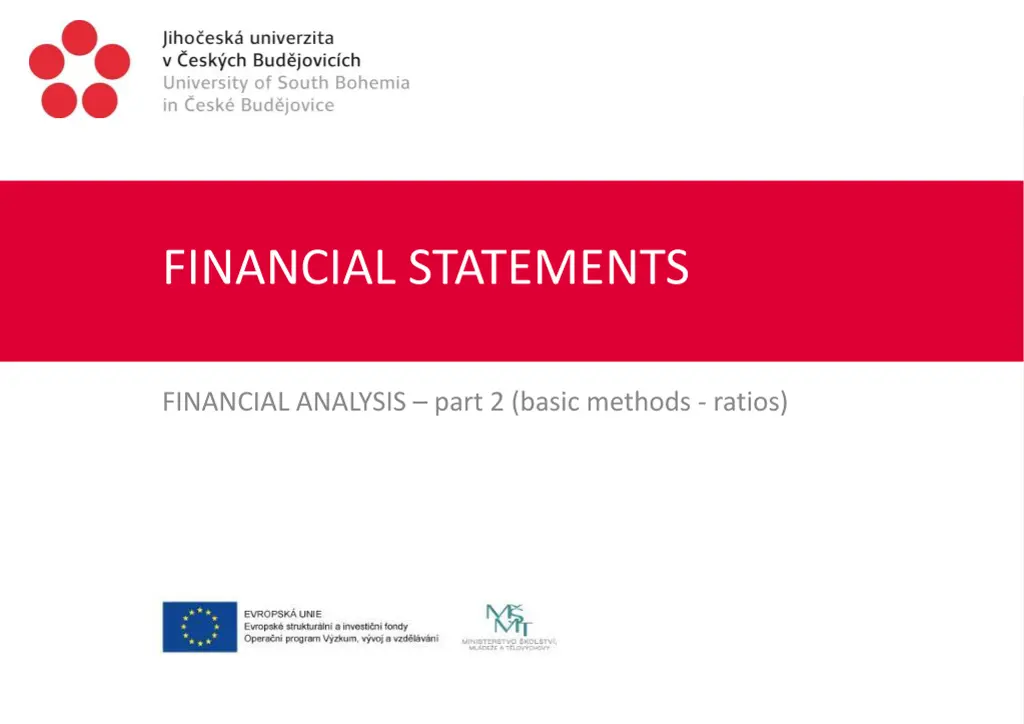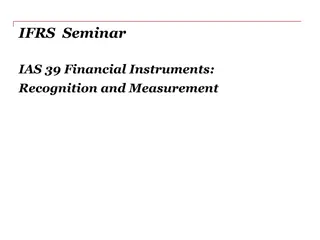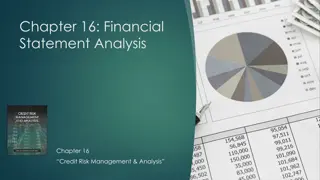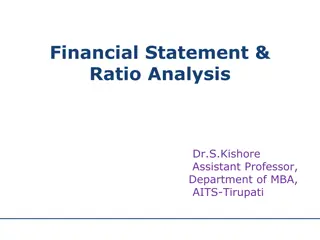
Financial Ratio Analysis: Methods & Advantages
Explore the significance of financial ratios in analyzing a company's condition and performance. Discover how ratios provide valuable insights for comparison and standards, aiding in the construction of financial models. Dive into profitability ratios, their types, and the critical role of profit in evaluating commercial firms for investment decisions.
Uploaded on | 0 Views
Download Presentation

Please find below an Image/Link to download the presentation.
The content on the website is provided AS IS for your information and personal use only. It may not be sold, licensed, or shared on other websites without obtaining consent from the author. If you encounter any issues during the download, it is possible that the publisher has removed the file from their server.
You are allowed to download the files provided on this website for personal or commercial use, subject to the condition that they are used lawfully. All files are the property of their respective owners.
The content on the website is provided AS IS for your information and personal use only. It may not be sold, licensed, or shared on other websites without obtaining consent from the author.
E N D
Presentation Transcript
FINANCIAL STATEMENTS FINANCIAL ANALYSIS part 2 (basic methods - ratios)
Ratio analysis Financial ratios = a tool of financial analysis. Financial ratio is simply an expression of the relation between two financial statements accounts and financial ration analysis it the investigation of a company*s condition and performance using one or more of these ratios. We use these ratios to get a measure of the relative value of one account to another. 15.07.2025 2
Ratio analysis A ratio has a numerator and a denominator, which converts the financial data to a percentage. This provides one approach to standardizing financial information for useful comparisons. The value of a given ratio, however, is rarely informative. Financial ratios provide information when compared to other financial ratios and standards. 15.07.2025 3
Ratio analysis Advantages of the construction ratios: reduce gross data, differing by company size, on a common basis, and therefore comparative allow to analysis of time development allow to construction of financial models. 15.07.2025 4
Profitability ratios Profitability ratios (also referred to as profit margin ratios) compare components of income with sales. They give us an idea of what makes up a company's income and are usually expressed as a portion of each euro of sales. The profit margin ratios we discuss here differ only by the numerator. It is in the numerator that we reflect and thus evaluate performance for different aspects of the business. Profit (profit/loss, earning, income) is the most important criterion for evaluating commercial firms for investment decisions. The most significant predictor of firm market valuation is profitability and the likelihood of continuous profit growth success of corporations. 15.07.2025 5
Type of profit/loss (earning, income) Gross profit equals sales revenue minus cost of goods sold Earnings before interest, taxes, depreciation, and amortization (EBITDA) Earnings before interest and taxes (EBIT) or operating profit Earnings before taxes (EBT) or net profit before tax Net income or earnings after tax or net profit after tax Retained earnings equals earnings after tax minus payable dividends 15.07.2025 6
Profitability ratios Gross profit margin Operating profit margin 15.07.2025 7
Profitability ratios Profitability ratios Return on equity - ROE 15.07.2025 8
Profitability ratios Return on assets - ROA 15.07.2025 9
Activity ratios Activity or turnover ratios are measures of efficiency and, generally, the higher the better. Typically, the numerator is an operating measure such as sales (revenues) or cost of goods sold and the denominator is a balance sheet measure such as inventory or receivables. Thus, operating flows are measured against asset and ether levels. Time series trends and comparisons to ether companies are useful to spot red flags or potential opportunities. 15.07.2025 10
Activity ratios Total assets turnover Sales = times pa Total assets Net asset turnover Sales revenue = times pa Capital employed 15.07.2025 11
Activity ratios Inventory turnover Inventory Cost of sales = * 365 days times pa Cost of sales Inventory Receivables collection period Trade receivable s * 365 days Credit sales 15.07.2025 12
Activity ratios Payables payment period 15.07.2025 13
Liquidity ratios Liquidity in the context of financial analysis refers to a company's ability to satisfy its short-term obligations using assets that are most readily converted into cash. Assets that may be converted into cash in a short period of time are referred to as liquid assets. These assets are listed in financial statements as current assets. Operating cycle How much liquidity a company needs depends on its operating cycle. The operating cycle is the duration between the time cash is invested in goods and services to the time that investment produces cash. 15.07.2025 14
Liquidity ratios Operating cycle GENERATE CASH CREATE ACCOUNTS PAYABLE Collect accounts receiavble Purchase raw material CREATE ACCOUNTS RECEIVABLE Sell goods Produce goods GENERATE SALES CREATE INVENTORY 15.07.2025 15
Liquidity ratios Working capital = total current assets - total current liabilities Current ratio (or working capital ratio) Current assets Current liabilitie s 15.07.2025 16
Liquidity ratios Quick ratio (liquidity and acid test) Current assets - Inventory Current liabilitie s Cash Position Ratio 15.07.2025 17
Debt ratios Leverage (also called solvency, gearing) considers the capital structure of the firm and the evaluation of the relative risk and return associated with liabilities (especially long-term debt) and equity (or ownership). A company can finance its assets either with equity or debt. Financing through debt involves risk because debt legally obligates the company to pay interest and to repay the principal as promised. On the other hand, equity financing does not obligate the company to pay anything; dividends are paid at the discretion of the board of directors. 15.07.2025 18
Debt ratios Leverage ratios are relatively easy to interpret for credit decisions: the lower the better. As debt increases, the potential for credit default decreases. Gearing ratios indicate: the degree of risk attached to the company and the sensitivity of earnings and dividends to changes in profitability and activity level. There are two types of financial leverage ratios: component percentages and coverage ratios. 15.07.2025 19
Debt ratios Total debt-to-assets ratio Debt-to-equity ratio 15.07.2025 20
Debt ratios Interest cover 15.07.2025 21
Limitations ratio analysis Ratios are a tool to assist analysis. They help to focus attention systematically on important areas and summarise information in an understandable form. They assist in identifying trends and relationships. However ratios are not predictive if they are based on historical information. They ignore future action by management. They can be manipulated by window dressing or creative accounting. They may be distorted by differences in accounting policies. 15.07.2025 22
Limitations ratio analysis Additional information In practice it is likely that the information available in the financial statements may not be enough to make a thorough analysis. You may require additional financial information such as: budgeted figures other management information industry averages figures for a similar business figures for the business over a period of time. 15.07.2025 23
Limitations ratio analysis You may also require other nonfinancial information such as: market share key employee information sales mix information product range information the size of the order book the long-term plans of management 15.07.2025 24






















